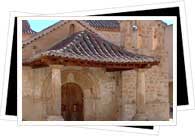Museums in Valencia, Spain
 Romanesque Architecture in Spain
Romanesque Architecture in Spain
As Spain's Christian forces crossed former Moorish strongholds- first in the north, then in the south- off their reconquista checklist, they certainly weren't willing to continue constructing in the Moorish architectural style. The first post-Islamic epoch of architecture was dominated by a style known as Romanesque.
Romanesque architecture then branches off into two related yet distinct strains. The first, known as "First Romanesque" or "Lombard Romanesque," arrived in Spain in the 10th century. Hailing from Lombardy, a region of northern Italy, the style simultaneously developed along the Mediterranean coast, spreading out of Italy and into southern France before crossing the Pyrenees and heading into the eastern Spanish region of Cataluña.
The second and more common strain of Romanesque architecture in Spain is what's known as the French model, a heavily French-influenced version that arrived slightly later than its Lombard counterpart. Making its mark primarily during the 11th and 12th centuries, French Romanesque architecture crossed into Spain over the Pyrenees before heading across northern Spain, following the Way of Saint James- a religious pilgrimage route to the city of Santiago de Compostela.
Romanesque Architecture Characteristics
Structures hailing from the "First Romanesque" architectural style tend to be simple and rather primitive, featuring thick walls, layouts of a single nave, a lack of sculpture, repeating geometric patterns and the presence of ornamental arches. Elements of the more widespread French-influenced Romanesque architecture are the presence of structures, layout in the form of a three-naved basilica or a cross. Some of the characteristics shared between the two include prominant apses, doors capped with layers of perfectly semicircular arches, "groin vaults" (vaulting in the shape of a criss-cross) and the use of stone vaulting instead of flat wooden ceilings.
Romanesque Architecture in Valencia
 The Romanesque presence in Valencia, having made its way into thea rea from neighboring Cataluña, is primarily found in the portals of some of the city'st most emblematic structures. The first- and most well-known- is the Puerta del Palau of the Cathedral. While some of the moldings of its capitals are more Gothic in their nature-based themes, this entryway- its the one that leads into the Cathedral from the Plaza de la Virgen- is made of stone and features repeating geometric designs and layers of perfect arcos de medio punto (arches in the form of a complete and perfect semi-circle).
The Romanesque presence in Valencia, having made its way into thea rea from neighboring Cataluña, is primarily found in the portals of some of the city'st most emblematic structures. The first- and most well-known- is the Puerta del Palau of the Cathedral. While some of the moldings of its capitals are more Gothic in their nature-based themes, this entryway- its the one that leads into the Cathedral from the Plaza de la Virgen- is made of stone and features repeating geometric designs and layers of perfect arcos de medio punto (arches in the form of a complete and perfect semi-circle).
You can seek out the second and and lesser-known example of Romanesque architecture in Valencia in the Iglesia de San Vicente (Church of Saint Vicente), which still preserves its simple rectangular shape and its Romanesque doors. The best example is the door that leads to the cloister of the monastery to which it was attached- check out its capitals narrating the rather gory martyrdom of Saint Vicente!
